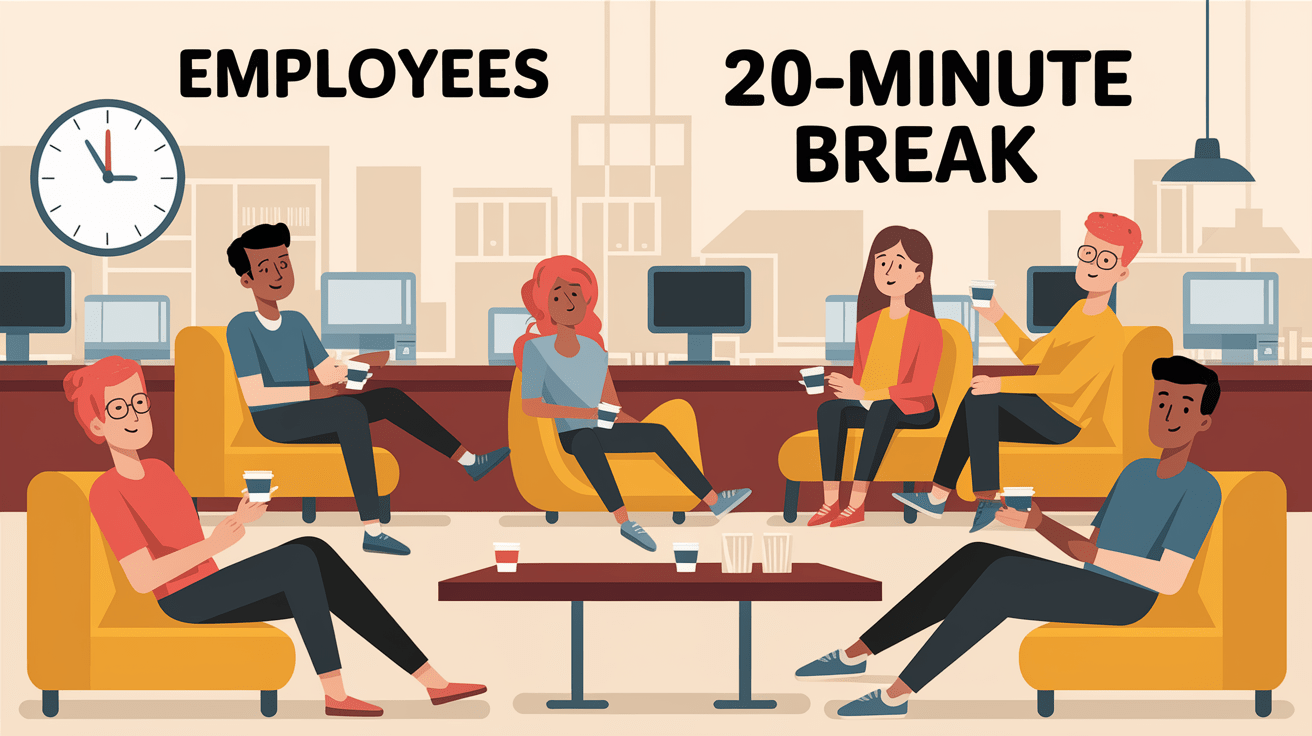Employment law in the UK guarantees employee break rights meaning workers have the right to rest breaks while on shift, as well as daily and weekly rest.
Statutory breaks can include a 20-minute rest (for anyone working over six hours) and regulations exist under the Working Time Regulations 1998. Being aware of what these rights are can help employees and their employers comply with the law.
The following sections cover important break types, exceptions and tips.
Your statutory rights
There are particular rules in UK employment law relating to breaks and working time, providing important safeguards for employee health and fair treatment in the workplace. Employers and employees have clear duties in relation to breaks, daily rest and weekly rest, with laws in place to protect against overwork and give everyone time to rest between shifts.
Knowing these rights prevents arguments, maintains a good morale and makes sure companies stay on the right side of the law.
1. The 20-minute break
All employees who work more than six hours a day are entitled to one uninterrupted 20-minute break. This needs to be away from their desk, taking space to think and refocus. Employers must ensure there is a clear and simple policy, so that all staff are aware of when and how to take this break, and managers should support this by never asking staff to work through or forego it.
Regular checks and transparent records help to identify if anyone is being denied their break. For example, maintaining a rota or log can flag recurring problems. Employees should be aware of this right by law, as it aids mental clarity and minimizes errors.
A healthy workplace culture means that breaks are not only permitted but encouraged, leading to a more effective and less stressful office environment.
2. Daily rest period
The law stipulates that employees must enjoy a minimum of 11 hours of uninterrupted rest between finishing one working day and commencing the next. This is a crucial aspect of break compliance, as it ensures that staff recover effectively. For instance, if a shift finishes at 8pm, the following one can’t begin before 7am. It’s essential for employees to check rotas and swap shifts to ensure this break policy is adhered to.
Uninterrupted sleep enables staff to recover and return to work sharp, promoting overall employee wellbeing. Long stints with insufficient time off are exhausting and can lead to employee burnout. Employers should schedule shifts carefully, particularly for workers doing night shifts or rotating shifts frequently.
If schedules make it impossible for staff to get their 11 hours, the law requires ‘compensatory rest breaks’—a longer break later to compensate for the lack of rest time. This is vital for maintaining good health and productivity in the workplace.
3. Weekly rest period
Employees should receive no less than one full day off a week, or two days off in 14 days. This can be two individual days or a single 48-hour block. Good rotas mean fair weekly rest for all workers”, even in intensive jobs, he said.
We all need this time to recharge and maintain a work-life balance. If workers take regular days off, they could fatigue or even burnout. Employers should utilise holiday systems and shift planning to ensure no one loses their weekly rest, and respond quickly if trends indicate anyone is being deprived.
4. Young workers
Young workers, who are under 18, have additional rights. If they work more than 4 and a half hours, they should get a 30-minute break.
They require a minimum of 12 hours break between shifts and two days off per week. Leave is controlled to encourage development and security. Younger workers should know their rights and feel able to speak out if breaks are skipped.
5. Compensatory rest
For those who don’t, compensatory rest is their legal right if they miss a break because of shift patterns or emergencies. If a rest can’t occur at the scheduled time, it should be taken at the earliest opportunity.
Employers must track every missed break and ensure substitute rest is provided. Staff need to be aware that they can request this, and managers should facilitate flexible breaks.
Navigating the exceptions
Break rights in UK employment law are subject to numerous exclusions, and not every workplace will comply with break laws. The law accommodates varied needs according to job type, age, employment contracts, or atypical working patterns.
When rules differ
There are exceptions in certain sectors, such as hospitals, bakeries, hotels, catering, agriculture, or postal or newspaper delivery, where rest breaks do not consistently follow the regular pattern. A bakery might go to work with the sun, and people in hospitals might be on shifts with just brief breaks. Retail and hospitality roles can have stressful periods where breaks are delayed.
Sports, arts and advertising employees can encounter peculiar hours or occasions that push typical regulations even more. In these industries, break entitlements may change according to business requirements, but minimum legal requirements must still be met by employers.
Whichever way you decide to go, the adjustment to regular break protocols must be communicated to all employees. Employers should use clear, simple language in handbooks or contracts to define ‘good cause’. This prepares workers for what to expect. Such misunderstandings only create an awful lot of stress – and disputes. If the workplace has statutory and additional contract-based breaks, this difference should be made clear.
Special circumstances
Certain jobs require a flexible approach to breaks. Night workers, for example, might require breaks at strange hours due to tiredness. Young workers – under 18 but past the age of school-leaving – by law have a 30-minute break if working more than 4.5 hours. Split shifts, such as in transport or cleaning, might require longer between breaks.
Disabled employees may need shorter or more frequent breaks as a reasonable adjustment. These alterations need to be ratified, documented and maintained. Managers must be trained to deal with these requests delicately and equitably.
It’s a good idea to have documented what’s been agreed. This reduces misunderstanding and protects either party if problems occur.
Contractual vs. statutory
Contractual breaks are the ones promised in a contract in writing. Statutory breaks are the legal minimum set by British law. Contracts should at minimum comply with the law. If a contract states “one 20-min break after 6 hours,” this complies with the law.
If it offers more, all the better. If a contract promises less, it should be revised. Workers should be aware of the distinction. Review contracts regularly – laws can change, and new requirements may appear.
Employers must have contracts that comply with the law. Otherwise they are open to lawsuits. Workers need to be informed of their contract rights and the fundamental legal principles. It avoids misunderstanding.
The pay question
Breaks at work are a legal right in the UK, but pay for those breaks is another thing. The Working Time Regulations 1998 say that most workers who work shifts of more than six hours should be given a 20-minute rest break. Still, there is no law that compels employers to pay for this time.
What goes in practice comes down to the employment contract or company policy. Certain companies – typically in factory work or jobs with long shifts – provide short breaks for employees to rest, but these tend to be unpaid unless company policy states otherwise. Individual workplaces set their own regulations on pay during breaks, so it is essential for both employees and employers to understand what is in the contract.
|
Break Type |
Paid? |
Example |
Employee Impact |
|---|---|---|---|
|
Statutory Rest Break |
Not by law |
20 mins in 8-hour shift |
No pay unless in contract |
|
Company Policy Break |
Varies |
Paid tea break in office |
Boosts morale, more pay |
|
Industry-Specific Break |
Varies |
Unpaid 10-min break in factory |
Less rest if not paid |
If a contract states breaks are paid (in practice break times, rostered or otherwise, are often not), the worker receives their normal pay for that period. If it doesn’t, that time is off the clock. It can translate into an actual change in your pay packet over weeks or months.
So, for instance, if you have a 30-minute unpaid break a day, five days a week, that’s not two and a half hours a week paid, which adds up over the year. On the flip side, paid breaks make employees feel that their time is respected. It increases morale and reduces stress and increases loyalty to the employer.
Some companies have opted to provide paid breaks to differentiate themselves and retain staff content. Others won’t, usually for economic reasons, but this can influence what workers think about their work.
Cut policies are significant. Staff should know whether breaks are paid or unpaid, with no uncertainty. That prevents further arguments down the track and earns trust. Written contracts should state whether a break is paid. If not, a staff handbook or letter should say so clearly.
Fairness counts. If breaks are unpaid, employees should be free to take them as they please, with no work pressure applied. Paid (or unpaid), the most important thing is that the time is genuinely a break from duties.
In short, the law leaves break pay to the employer but equitable and transparent policies benefit all. Breaks, paid or not, should accommodate the worker’s need for downtime (and recognise their time).
The modern workplace
Work in the UK has fundamentally changed. Employees are working from home, on the move and in flexible ways. The law entitles you to a 20-minute break if your shift is longer than six hours. Under-18s get more: a 30-minute break for each 4.5 hours worked, plus longer daily and weekly rests.
All need 11 hours’ rest at minimum between shifts. These rights are intended to reduce fatigue, prevent accidents and maintain health, but many struggle to take adequate breaks, especially with work and home increasingly blurred. Technology allows us to be connected anywhere, but it makes us “always on” – a potential pathway to burnout. Employers consider wellbeing, health and job satisfaction now in the face of these new challenges.
Remote working
Remote work presents a new struggle for breaks. Employees at home may drop tea breaks or extend the working day. Minor measures may assist. Set clear rules: state when and how often breaks should happen.
Get used to stepping away from the screen. Tech can assist here. Do use shared calendars for break reminders. Consider virtual break rooms, where employees can talk and chill as they would in a workplace break room. Regular check-ins continue to connect people in and identify signs of overwork.
Managers need to monitor work behaviours, not only hours, to identify if legal breaks are skipped. All of this contributes to a work culture in which employees feel safe taking a break, reducing the likelihood of burnout.
Flexible hours
Flexible hours can mean staff work early, late or split shifts. It’s important to sync breaks to these rhythms. Allow employees the freedom to schedule breaks that suit their day, rather than having to rush or miss them.
Make it clear: breaks matter as much as the work itself, even if hours move around. See how these rules operate – check in with staff to see whether breaks help them rejuvenate and perform better. Response will result in changes, flexible break policies accommodating actual needs.
A policy that responds to people’s lives, not vice versa, stands a better chance.
Gig economy
Gig work is increasing. These employees usually work no-shift, so breaks can go unnoticed. Most people aren’t aware of their rights to respite and breaks.
It’s crucial to communicate these rights transparently – put them on apps or sites workers use. Request breaks during extended shifts. Track breaks and raise red flags. When workers understand their entitlements and receive support, their health and safety is better safeguarded.
Beyond compliance
Employee break rights, derived from employment law for employers, are the minimum, but increasing numbers of UK employers now strive to do more. Exceeding basic requirements makes employees feel appreciated, boosts morale, and benefits long-term business objectives.
A more expansive approach can mean additional breaks, flexible working hours, and holistic wellbeing support. Such actions can improve job satisfaction and loyalty while assisting employers in securing and retaining talent.
A culture of rest
Encouraging a culture of rest begins by ensuring staff feel they can take breaks without guilt. Having a policy is not enough – employees need to feel comfortable leaving their desks.
Deserved break places – whether meditation rooms, greenery, or social spaces – demonstrate a belief in genuine recuperation and give employees space to revive. Inserting wellness breaks including step walks, team exercises, or mindfulness can prompt individuals to take a moment to think about their wellbeing.
Celebrating teams who build rest into their practice, by telling their stories or giving them a small reward, gives other teams a clear model to follow. These initiatives are not only about ticking a legal box but creating a work environment where people actively want to remain.
-
Regular walking groups at lunch
-
Quiet zones for reading or reflection
-
Free fruit and healthy snacks in break areas
-
Flexible start and finish times
-
Mindfulness or yoga sessions on-site
-
Recognition for teams who promote healthy break habits
The productivity link
Regular breaks do wonders for productivity and concentration.
-
Improved concentration: Stepping away from work for even a short time can help staff return with better focus and less fatigue.
-
Fewer mistakes: Breaks reduce the risk of errors due to tiredness, which helps maintain quality and safety.
-
Greater creativity: Time away from tasks often sparks new ideas and problem-solving.
-
Higher engagement: When employees feel trusted to manage their time, they are more motivated to do their best.
Managers are key to ensuring teams take breaks that fit around their workload. It may mean scheduling workloads with breaks factored in, or being flexible about break patterns.
Productivity figures, whether output per hour or error rates, can indicate whether existing break policies are effective. Training on break strategies – for example, how to get away from screens or incorporate shorter walks into the day – can help staff to use their time more effectively.
Legal vs. best practice
While legal entitlements to breaks are a baseline, best practice is to go beyond the minimum. Best practice is to review policies regularly to ensure they comply with the law as well as staff requirements.
Such actions might mean providing additional leave, allowing employees to choose their own break times or delivering training and support for enhanced wellbeing. A culture where staff can raise their break requirements openly supports everybody in getting the recovery they deserve.
Employers that go beyond compliance tend to get improved retention and reduced absence. They’re attractive to top talent who want a workplace that cares about health and happiness.
When rights are ignored
When break rights are ignored, it has immediate and severe repercussions for both employees and employers. UK workers do have a statutory right to rest breaks, particularly on shifts longer than six hours. These rights aren’t just formalities – they lie at the heart of workplace health, safety, and fair treatment.
When these fundamental principles are overlooked, it frequently results in fatigue, workplace errors, and an increase in sick leave. Absence of defined policies or constant refusal of breaktimes – like being told to continue working unpaid – are indications that rights are endangered.
Employer liability
Employers that do not follow break rules expose themselves to genuine legal risk. In the UK, the consequences for ignoring rest break rules may be tribunal claims or reports to the authorities. If a worker on a 12-hour shift is refused even the one 20-minute rest break they are entitled to by law, this is a breach of the Working Time Regulations.
Employers need to make sure that they are training managers on the rules relating to breaks and why it’s important to stick to them. Regular training should encompass both the law and good workplace practice.
Regular audits, such as examining rosters and analysing shift patterns, can identify issues before they become legal problems. Employers who disregard break rights are susceptible to claims, so it’s vital to have a clear process for dealing with disputes.
Employee recourse
If you feel your break rights are being denied, what can you do? Firstly, you can go to your manager or check with your outsourced HR partner and try to sort the matter out informally. Having a personal log of when breaks are missed or denied is crucial.
This evidence is useful if the problem has to be escalated more formally or pursued further. Workers should have support, whether that’s from a union, a legal adviser, or a workplace advocate.
A healthy workplace is one where employees are confident to flag issues without concern of being victimised or persecuted.
The tribunal process
If informal measures don’t work, the employee can bring a case in an employment tribunal. It begins with a formal grievance, then (if not resolved) a claim to the tribunal service. Staff must be clearly told what to expect – from form filling to hearings.
When it comes to trends in tribunal cases, both employers and workers are served by understanding them. These can demonstrate where policies must evolve. Better to at least have sought for an honourable settlement before it comes to this.
Employee Break Rights FAQs
What are the statutory break rights for employees in the UK?
The UK’s Working Time Regulations 1998 ensure that most adult workers have a break entitlement of a 20-minute uninterrupted rest break when working over six consecutive hours.
Are rest breaks paid under UK employment law?
Employers do not have to pay you for rest breaks, as this will depend on your employment contract or workplace policies regarding break compliance.
Can my employer refuse my statutory break?
No, an employer can’t deny you your legal entitlement to a statutory break if you work over six hours, as this is a legal requirement under break laws. The timing of the rest break can be determined by the employer.
Are there exceptions to statutory break rights?
Yes. Some roles, such as emergency services or jobs involving continuous cover, might have different break regulations, including legal break requirements, which are contained in certain employment contracts or collective agreements.
Do under-18s have different break rights?
Yes. Under 18s have a legal requirement for a 30-minute break if they work over 4.5 hours, alongside 12 hours of rest between shifts.
What should I do if my employer ignores my break rights?
If your employer disregards your legal break requirements, such as taking breaks or rest periods, bring it up with them first. If it still is not resolved, you can contact ACAS or make a claim to an employment tribunal.
How do break rights apply in remote or flexible work?
Break rights extend to remote workers and flexible workers alike. Employers must ensure compliance with break laws, allowing all staff to take statutory breaks, regardless of their working conditions.

















